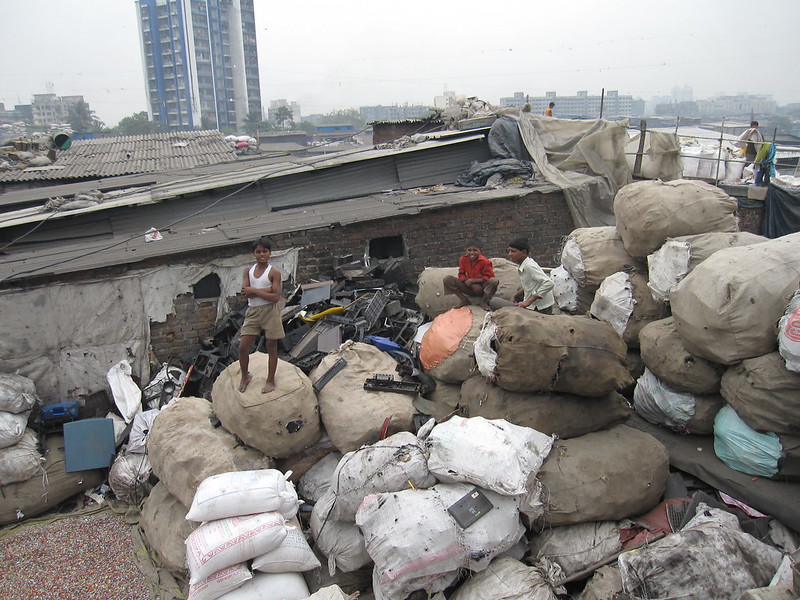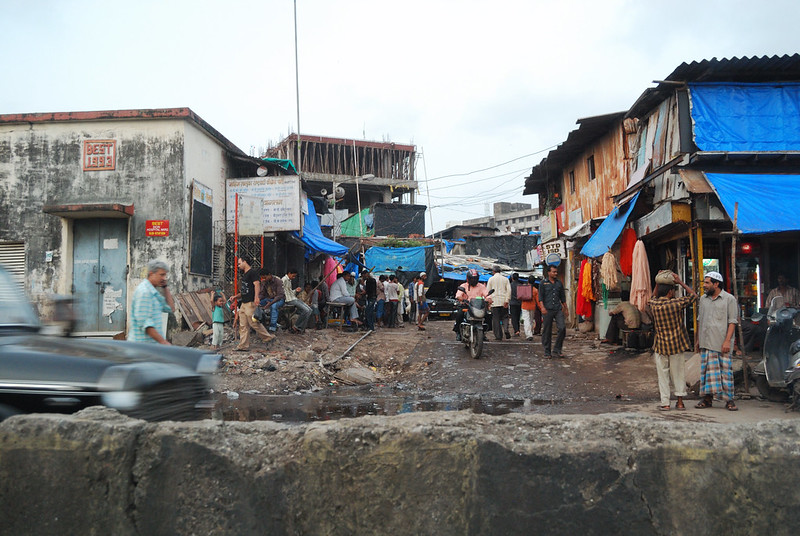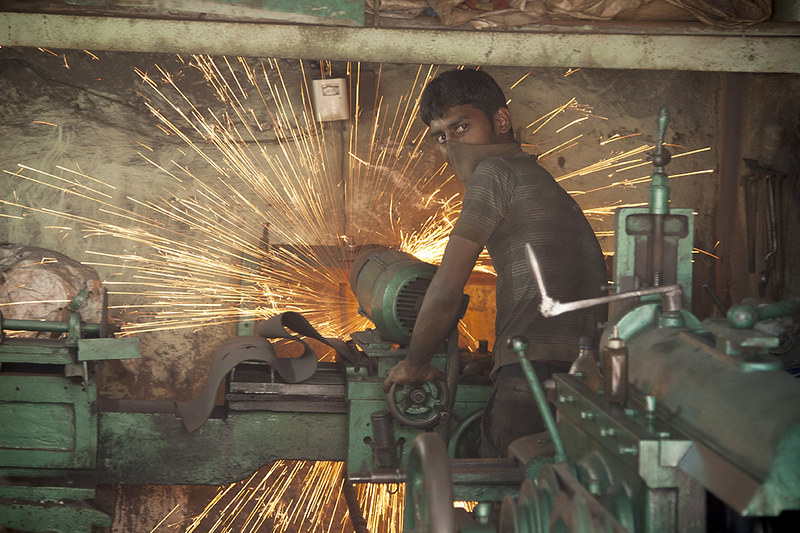15-02-2021
Dharavi: tourism in the biggest slum in Asia
Alejandra López | Alba SudDharavi is presented as a unique place, where precariousness but also hard work prevail. During the past few years, it has received growing tourist attention that has placed it in the middle of a broad ethical controversy, becoming the reflection of an inequality-based society.

Crédito Fotografía: Dharavi. Fuente: Ishan Koshla, bajo licencia de creative commons.
During the past months, the COVID-19 pandemic has caused, among other effects, a stop in the tourism sector at an international level that has affected big and small communities where tourism was a big factor in their economy, as well as thousands of workers. Nonetheless, this situation brings us the opportunity to rethink the way we make tourism and to get to know which are really the sector’s impacts on the visited area, especially in circumstances such as the ones we are living today. Dharavi, in Mumbai, was already in a vulnerable state before seeing the number of tourist grow up during the past years. At the same time, this activity has been highly linked to ethical controversies that question the use of poverty as a tourism attraction, usually justified by its economic contribution to the territory.
There are more millionaires in Mumbai than in all Indian cities together and the renting prices are among the highest in the world (Schubert, 2009). Simultaneously, this city presents another reality that is quite distant from luxury and abundance. If we want to know about a completely different Mumbai, we have to transfer to the so-called “slums”, defined by the UN-HABITAT (2003) as groups of people living inside the same urban area that find themselves under minimum one of the following circumstances: (1) inadequate access to safe water, (2) inadequate access to sanitation and similar infrastructures, (3) poor structural quality of housing, and (4) overcrowding and insecure housing status. Nevertheless, it is important to have into account that each slum is different and is influenced by many geographic and sociocultural factors that make it complicated to reach an agreement on the definition.
At the city of Mumbai, one of the most populated worldwide, there are around 2.000 slums, where approximately 10 million people live and where everyday many families start new lives with the hope that they will find new opportunities (Schubert, 2009). More than a 40% of the “houses” (usually constructions made out of corrugated plate, fabric or tents) are smaller than 10 m2 and three quarters of the population have to use common restrooms (Dyson, 2012). These are only a few aspects that the dwellers of this kind of settlements have to face, not only in India but in many other countries, such as the case of Kibera, in Nairobi, or some parts of Soweto, in Johannesburg.

Recycling unit in Dharavi. Source: erin, Creative commons licence
When talking about slums, especially in India, there is one that stands out above the rest. Dharavi is often described as ‘the city inside the city’ or ‘Mumbai’s heart’, not only for being the biggest slum in the whole Asian continent, but also because it has some characteristics that make it different to many comparable places. Regarding its population, during a questionnaire from 1986 530.225 people living in 80.518 structures were counted, although nowadays this number exceeds the 700.000 inhabitants (Iyer et al., 2009, citen in Dyson, 2012) and it is even suggested that it has already reached one million, according to Mahawar (2015). Despite the existence of many challenges in the daily life of Dharavi, such as that an average of 5-6 people share a one-room-dwelling, that the water runs only for three hours a day or the appearance of pathologies related to the quality of the water and other resources, this slum presents a special economic context. Approximately an 80% of the population in Dharavi is employed inside the slum and it accumulates an annual turnover of around 665 million USA-dollars (Patel & Jockin, cited in Dyson, 2012), mainly thanks to the big industrial network formed by small manufacturing units. One of the most important ones is the leather industry, which is exported in big quantities to big brands; another one is recycling, reaching up to an average of 4 tones of plastic per day, aspect that also suggests the importance of waste-management and landscape-maintenance in the city of Mumbai. Other units are focused on wax printing, fabrication of aluminium blocks and ceramics (Mahawar, 2015).
Tourism in Dharavi
The whole economic activity based at ‘the heart of Mumbai’ is not only formed by industrial networks, but also tourism. This activity is recognised under the concept of “slum tourism” and it consists of carrying out guided tours through settlements such as Dharavi or those of similar characteristics, although they can differ significantly between regions and service providers. In this case, this phenomenon’s magnitude has reached surprising digits, turning it into an essential tourist attraction for the city and overpassing other internationally recognized spaces, such as the Taj Mahal. Part of this growth would have probably not been possible without the indirect support of certain communication mediums, especially with films such as the rewarded “Slumdog Millionaire” (2008), which also play an important role when representing its image and the tourists’ expectations prior to the visit. Nonetheless, its popularity has not grown without causing a moral dilemma that swings from ‘an educative experience’ to what is considered as degrading and voyeuristic, a usual controversy in global discussions about slum tourism.
This phenomenon’s origin dates back to 2006, when the tour operator Reality Tours and Travel (RTT) officially initiated its activity. This company was founded by the British Chris Way, inspired by the favelas in Brasil, and a local non-Dharavi-resident, Krishna Pujari. Their motivation and mission is to provide educational experiences that show the slum’s reality, as well as trying to break down stereotypes and wrong conceptions about the area, adding an optimistic viewpoint at the same time that the industrial units are visited and the tourists get in contact with a hard-working welcoming community. Moreover, most part of the benefits are sent to neighbourhood-improvement initiatives and charities. They even currently and since 2009 operate their own non-profit-organisation: Reality Gives (RG) (Frenzel, 2017).

Dharavi. Source: Ting Chen, Creative commons lincence.
From 2011 on, other tour operators have appeared, mainly formed by local Dharavi families that have taken profit of the slum’s popularity growth, although they remain smaller and as alternatives to RTT. Among these, a more personalized service and a wider variety of narratives can be observed, such as the case of Be The Local, which delivers a more political discourse in relation to Dharavi’s situation; a topic that the pioneer tour operator has generally avoided (Frenzel, 2017).
The perspectives of Dharavi’s dwellers about tourism
Despite the broad debate about slum tourism, when talking about the perspectives of the different participants, it is obvious that the scientific literature has been addressing a much greater attention to the visitors opinions, and therefore having much less into account the points of view of local residents. The reasons are usually the language barrier between locals and the investigation team, as well as the general difficulty of a research of such characteristics (Freire-Medeiros, cited in Silkker & Koens, 2015).
In the case of Dharavi, Silkker and Koens (2015), throughout a study that focuses on the inhabitants, divide the locals’ perceptions in three different positions: those with a positive viewpoint, those with a negative consideration and those that are neutral. The answers suggested that most of the people belonged to the first category, they even claimed to feel proud when seeing that tourists were interested in their community. The authors highlight that the economic aspects provided by the tours have not been talked about enough, even getting to a point in which the residents themselves claim a little bit of support to the territory, suggesting that they are not aware of what is being made and or that they do not feel the benefits in their daily lives.
Those who maintain more neutral or negative perspectives usually refer to their concern about the tourists’ security, especially when visiting the factories and industrial zones, which often use toxic or dangerous materials. Any harm caused to a visitor, although it might have been entirely its fault or the local person might have not even part of it, could lead to official complaints and police involvement. Other concerns focus on the possibility of tourists spreading an image of dirtiness, poverty and illegality, which can associate Dharavi’s name with negative concepts and offend its population (Silkker & Koens, 2015).
COVID-19 affectations
As its characteristics suggest, slums are especially fragile territories in epidemies such as the COVID-19. A great number of people live in small spaces, they depend on common restrooms and have insufficient hygiene conditions, as well as having very few economic and medical resources. In zones like Dharavi we could say that social distancing is a luxury that no everybody can afford. Regarding the number of infected cases, during the last few months an important difference between the residents of Mumbai and those living in the slums has been observed. Among the latter ones, antibodies have been found in more than half of the population, while at the remaining areas of the city the number does not reach a 20%.

Man working at a workshop in Dharavi. Source: Meena Kadri, Creative commons licence.
Furthermore, the imposed quarantines and measures have shut down the industrial units that moved the local economy and have taken away many people’s job. Some of them have had to go back to their hometowns or to indebt themselves. Many families could get meals due to the participation of wealthy politicians, NGOs, businesspeople, and Bollywood actors. Moreover, this can be associated with the previously mentioned popularity of Dharavi, and how this international interest focus has remained during the pandemic, attracting thus a greater assistance volume.
As far as tourism is concerned, there is yet very few information regarding the situation of operators, residents, and other agents. The websites of some tour providers suggest that the tour offer remains open, as it is the case for Be The Local, while some other have limited their activity to some spaces, as it is the case of Reality Tour & Travel, which maintains some Delhi tours but not those in Mumbai. Nonetheless, it would be interesting to understand better how this tourism hiatus has affected a territory where tourism has been growing significantly during the past years; at the same time, the degree of responsibility from slum tourism practices when introducing the virus in the area could also be analysed.
Concluding thoughts
Dharavi represents one more territory where the tourism sector burst into unexpectedly and justifies its presence and its importance with primarily economic arguments, without considering with the necessary depth how the development of such activity can affect the environment. This factor stands out in areas like Dharavi, which is rather isolated from the city, where informality reigns and a sustainable tourism management is not an easy task, especially taking into account that until recently the government did not position in favour of this practice.
The offer of tours through this Mumbai’s slum is a relatively recent activity and, despite the generally positive reception, its growth could lead to these people’s dissatisfaction and even generate conflicts. This would not be surprising when taking into account many other cases of visitor-visited co-habitation and then adding the security, working and privacy conditions with which slum inhabitants have to deal when receiving tours.
Aside from the debate around slum tourism, it is necessary to understand in more detail the resident’s position, its role regarding tourism practices, the impacts that they entail and its implication at decision-making. In order to achieve that, it is essential that the slum’s local population itself gains knowledge about this phenomenon and its (potential) repercussions in the area.
Moreover, it would be necessary to put this phenomenon in perspective and actually question its positive and negative impacts inside the territory, as well as the roles each participant play. Although slum tourism could be argued as a group of people who want to learn about other cultures, it also becomes the reflection on a society based on class and economic inequalities, and it brings attention to the necessity for change towards the protection of a territory and a population that were already vulnerable at many levels before tourism arrived.
Finally, we should be aware of the important role that tourism could play in areas such as Dharavi, both regarding its beneficial or damaging influences. Since the COVID-19 pandemic, we have seen how the already precarious conditions of many communities have been affected by the sector’s fragility, exposing the necessity for local agents to manage situations like the one they are living today, as well as to work towards an actually inclusive, sustainable and beneficial future for the territory.
Noticias Recientes
-
El Observatori de la Vida Quotidiana y las memorias de los barrios de Barcelona
Noticias Generales | 31-10-2024 -
Guanacaste, entre el techo y el turismo: un especial de La Voz de Guanacaste sobre la pugna por el derecho a la vivienda
Noticias Generales | 29-10-2024 -
Jornada: Turismos y memorias en la ciudad de Barcelona
Noticias Generales | 28-10-2024 -
Costa Rica: vacaciones y jornadas laborales entran en el debate sobre el turismo nacional
Noticias Generales | 24-10-2024 -
Carlos Aramayo (Unite Here): «Estamos en huelga»
Noticias Generales | 22-10-2024 - | Archivo de Noticias »

